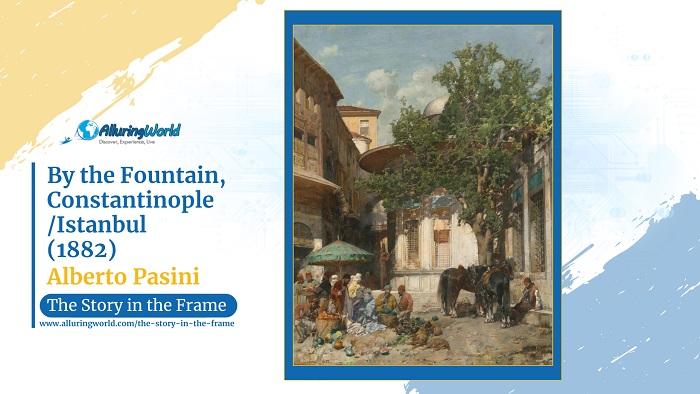By the Fountain, Constantinople/Istanbul by Alberto Pasini is a vivid and atmospheric painting that represents daily life in the Ottoman Empire, and it was painted in 1882. As one of the most skilled Orientalist painters of the 19th century, Pasini masterfully captures the essence of a bustling yet tranquil scene, where figures gather around a fountain in the heart of the city, and his deep fascination with the architecture, culture, and people of the East is evident in this painting, which brings to life the rich textures, vibrant colors, and dynamic social interactions of Istanbul at the time.
About the Painter:
Alberto Pasini (1826–1899) was an Italian painter renowned for his Orientalist works, which depicted scenes from the Middle East, North Africa, and the Ottoman Empire, and after accompanying a diplomatic mission to Persia in 1855, Pasini became deeply inspired by the exotic landscapes, architecture, and people he encountered. Unlike many Orientalist painters who relied on imagination, Pasini’s firsthand experience lent authenticity to his depictions, as his work is characterized by precise details, atmospheric light, and a masterful use of color, making him one of the most respected European painters of Eastern scenes in the 19th century.
Inspiration and Reasons Behind the Painting:
Pasini’s fascination with the Ottoman world stemmed from his extensive travels through Turkey, Egypt, and Persia. His works often highlighted the everyday life of these regions, blending architectural grandeur with human activity, so By the Fountain, Constantinople/Istanbul reflects his keen eye for detail and his appreciation for the harmony between urban spaces and social interactions. Because fountains held significant importance in Ottoman cities as they served as essential gathering points for travelers, merchants, and locals, so this painting likely aims to capture this vibrant yet routine moment, celebrating both the architectural beauty of the city and the cultural significance of public spaces.
What is Depicted in the Painting:
The painting presents a group of people gathered around an ornate fountain in the streets of Constantinople, which nowadays is known as Istanbul. The fountain, possibly an ablution fountain near a mosque or a sabil (public water fountain), features intricate Islamic designs and calligraphy, but the figures in the scene likely include merchants, travelers, and locals engaged in conversation or resting in the shade. Some in the background may be performing ritual washing which is a common practice in Islamic culture. The architecture surrounding the scene showcases the usual Ottoman-style domes, arches, and decorative tilework, reinforcing the setting’s authenticity, where the atmosphere is lively yet peaceful, with a balance between human presence and the grandeur of the city’s landmarks.
Colors and Techniques:
Pasini’s color palette in By the Fountain, Constantinople/Istanbul is rich and dynamic, featuring warm earth tones, deep blues, and golden hues that highlight the city’s sunlit splendor. His use of light is particularly striking, as it filters through the scene, casting soft shadows and illuminating the architectural details. The textures of stone, fabric, and water are rendered with meticulous precision, demonstrating his ability to capture the materiality of the environment, and his brushwork is both refined and expressive, lending a sense of movement to the figures while maintaining architectural accuracy.
Conclusion:
In conclusion, By the Fountain, Constantinople/Istanbul is a remarkable example of Alberto Pasini’s ability to blend realism with artistic elegance. The painting not only offers a glimpse into the daily life of 19th-century Istanbul but also serves as a testament to the importance of communal spaces in Ottoman society, and through its masterful use of color, light, and detail, the artwork remains a valuable historical and artistic record of a time when East and West met in the vibrant streets of Constantinople.

